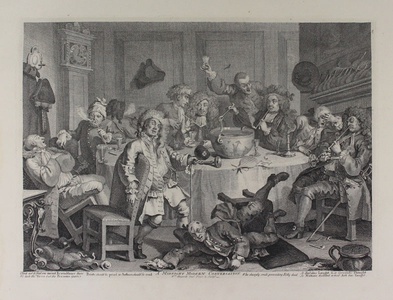| Method | Copper engraving |
| Artist | William Hogarth |
| Published | Wm. Hogarth Invt. Pinxt. & Sculpt. 1733. [J & J Boydell c.1795] |
| Dimensions | Image 330 x 460 mm, Plate 350 x 475 mm, Sheet 440 x 588 |
| Notes |
Hogarth's 'A Midnight Modern Conversation' was one of his most popular early works, and a superb example of the influence of Dutch genre painting on the artist's work. Indeed the many pirated copies of this early work contributed to the rapid increase of Hogarth's fame in Europe, particularly in France and Germany. The scene takes place in St John's Coffee House, Shire Lane, Temple Bar, and portrays the final throes of a raucous evening of drinking, debate, and mild debauchery among a large group of men. The characters, exhibiting the various degrees of inebriation, are gathered around a large oval table. The characters themselves have been variously identified, with a number likely to have been Hogarth's own friends and acquaintances. At centre, the broadsword fighter James Figg, present in a number of Hogarth's scenes, has fallen from his chair, smashing the bottle he carries in his left hand. The gentleman who spills the contents of another bottle on the prostrate Figg is usually identified as Ranby, Hogarth's doctor-friend. To the extreme right, a politician attempts to light his pipe with a candle stick, mistakenly setting alight his coat sleeve by mistake. The man next to him clutches at his face, either gripped by headache or in preparation to be violently sick onto the floor. At the centre back, four men gather around the punchbowl. The one idly ladling at the punch is likely the parson, Cornelius Ford, a cousin of Dr Johnson. At the far left, another friend of Hogarth's, the bookbinder Chandler, sits in an attitude of melancholy, wearing a white turban and smoking a long pipe, while another, leaning back on his chair, has fallen asleep with his mouth open, his wig falling back to reveal a bald pate. The scene is strewn with broken bottles and discarded pipes, while the clock and snuffed candles hint at the approaching dawn. In the inscription space, under the title 'A Midnight Modern Conversation,' a poem in three couplets reads: 'Think not to find one meant Resemblance there / We lash the Vices but the Persons spare / Prints should be priz'd as Authors should be read / Who sharply smile prevailing Folly dead / So Rabilaes Laught, & so Cervantes Thought / So Nature dictated what Art has Taught.' William Hogarth (1697 - 1764) was born in London, the son of an unsuccessful schoolmaster and writer from Westmoreland. After apprenticeship to a goldsmith, he began to produce his own engraved designs in about 1710. He later took up oil painting, starting with small portrait groups called conversation pieces. He went on to create a series of paintings satirising contemporary customs, but based on earlier Italian prints, of which the first was The Harlot's Progress (1731), and perhaps the most famous The Rake's Progress. His engravings were so plagiarised that he lobbied for the Copyright Act of 1735, commonly referred to as 'Hogarth's Act,' as a protection for writers and artists. During the 1730s Hogarth also developed into an original painter of life-sized portraits, and created the first of several history paintings in the grand manner. Paulson 128 iii/iii, BM Satires 2122 Condition: Good impression with full margins, light crease to top centre of image. Light water stain to left margin, and wormhole damage to top right corner of sheet, neither affecting image or plate. |
| Framing | unmounted |
| Price | £700.00 |
| Stock ID | 47325 |

